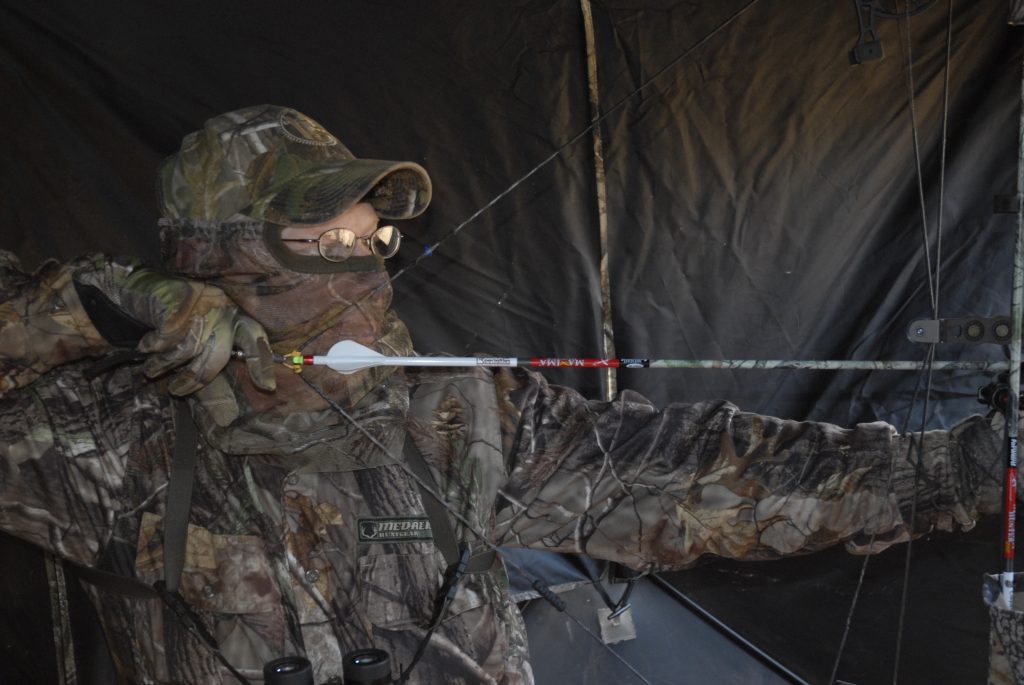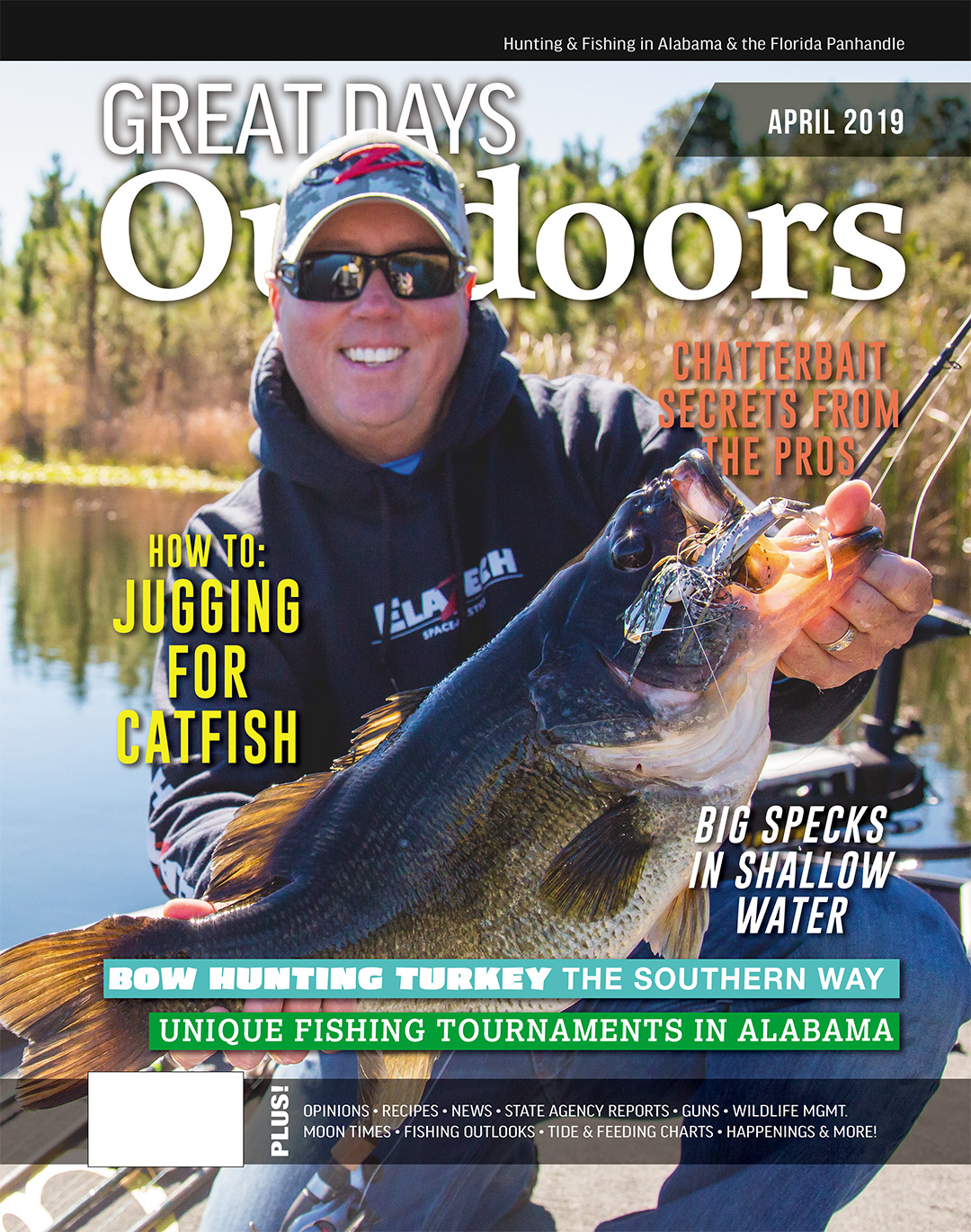A turkey hunter needs nerves of steel, the shooting confidence of Robin Hood, the woodsmanship of Daniel Boone, the positive attitude of Dale Carnegie, and some good turkey broadheads to bag a gobbler with a bow. Most hunters agree that bow hunting turkey usually means they’ll have 10-1 odds against themselves. Some of the best turkey hunters and bowmen I know, including Ronnie Strickland, Dale Faust, John Demp Grace, Brad Harris, David Hale and Mark Drury, share their secrets for success here.
What’s the Most-Critical Key for Success
Although manufacturers have designed plenty of equipment specifically for taking turkeys with a bow, most archers name accuracy in shooting as the most critical key to bagging a bird. The bowhunters I know who consistently harvest toms every spring change their equipment very little from how they bowhunt for deer, except for their turkey broadheads. Using the same equipment you’ve utilized during deer season to set-up the same way when you hunt turkeys will increase your comfort level with your tackle.
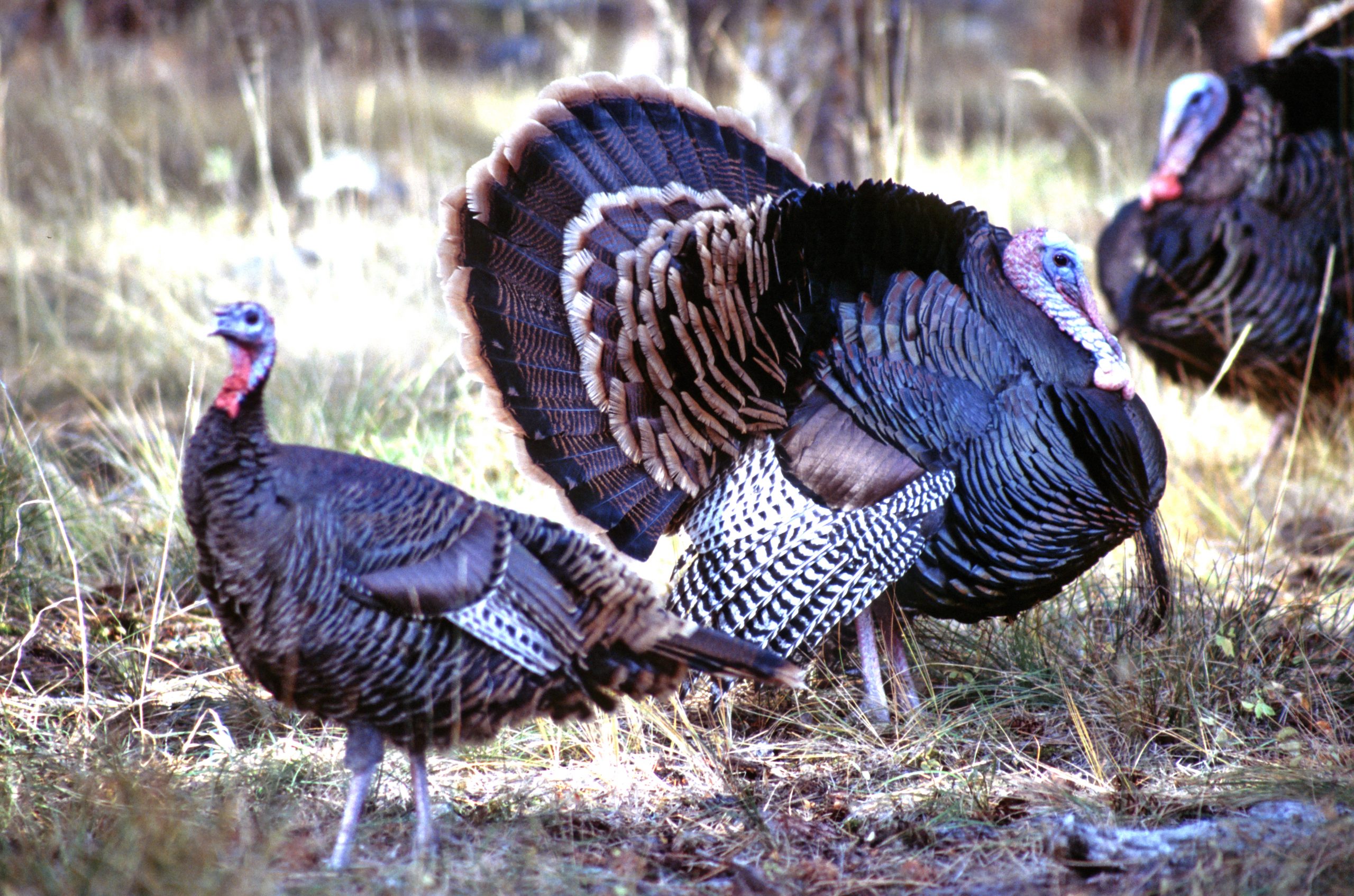
How Ronnie “Cuz” Strickland Bowhunts Turkeys
Since turkeys respond quicker to sound than even deer, Strickland with Mossy Oak in West Point, Mississippi, takes his bow apart, separates the limbs from the risers and puts pool-table felt between the risers and the limbs to quieten his bow for turkey season. Strickland also uses large puffs on his string to quieten the string even more, places felt on his arrow rests and waxes his arrows with furniture polish. Strickland says, “You can learn just how noisy your bow is by going into a closed room and drawing it.”
What about Bow Weight
Some hunters believe a heavier bow that produces faster arrow flight decreases the chances of the turkey’s moving during the arrow’s flight. However, if you pull a heavy bow and have to hold the bow at full draw for some time, waiting for the turkey to get into the position for you to shoot, you may miss the bird. Many turkey hunters consider a 50-60-pound bow more than adequate for downing a longbeard.
Where to Place the Shot and Why to Use Decoys
Avid bowhunter Dale Faust of Brewton, Alabama, says that, “The best shot to take at a turkey is the spine shot. Because turkeys won’t leave a blood trail like deer and other big-game animals, you may have a difficult time retrieving the turkey, unless you break the bird down. I shoot a 72-pound bow and a Land Shark broadhead made by Simmons, a broadhead that’s about 160 grains and has a 1-9/16-inch cutting radius.”
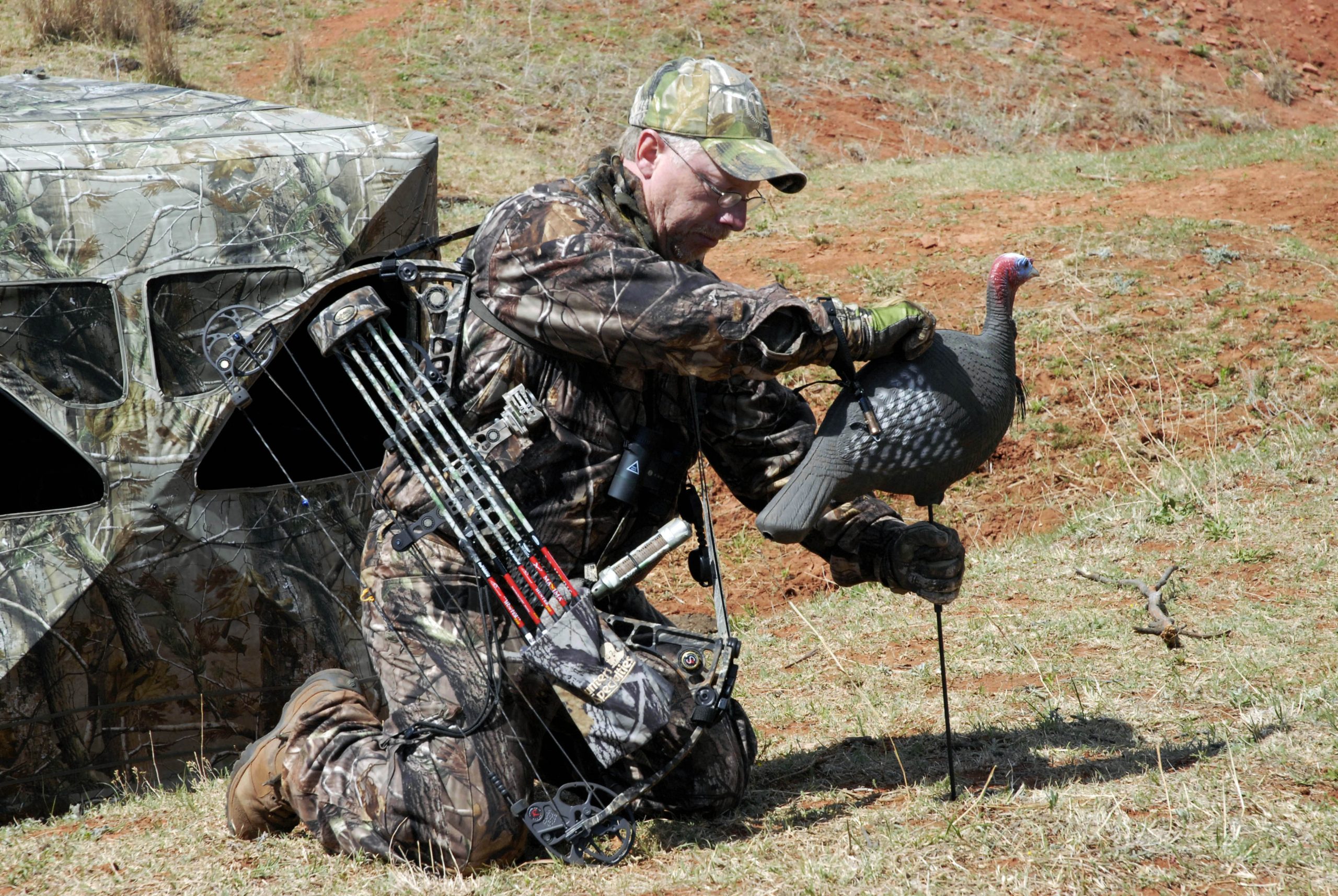
“I put a star-type stopper behind the broadhead and use the stopper for extra drag and knock-down power. Also bigger broadheads that inflict more damage on impact will aid in bowhunting turkeys. The large broadhead will go through more parts of the turkey and more than likely will cut more vital areas than a small broadhead will. I use turkey decoys to keep the turkey’s attention focused on the decoy instead of me.”
Whether to Blind or Not
Some bowhunters feel they can move quicker and set-up faster without a blind. However, without a blind, you don’t have a place to hide your movement from turkeys when you’re bowhunting.
“Often when bowhunters set up to take turkeys with their bows, they don’t think about back cover,” Ronnie Strickland observes. “I also prefer to have plenty of cover on either side of me. The tom can’t watch me draw and I can wait on the bird to step in front of me. Side cover often is just as critical as back cover when you’re hunting without a blind. However, I think using a blind is more critical to your success in the West than in the East where generally there’s plenty of cover available.”

John Demp Grace of Cuba, Ala., both a master archer and a fine turkey hunter, uses a quick-to-assemble blind he’s developed that totally covers him but has several shooting ports on all sides.
“I’ve used this blind in the West,” Grace reports. “In places with very little cover, the blind’s an absolute must, as is hanging or leaning brush against the blind to break-up the silhouette of a blind and keep the material from moving in the wind.”
Brad Harris’s Tips
Brad Harris, a nationally-known outdoorsman and videographer, has hunted turkeys with a bow for almost four decades. Shooting a 75-pound bow, Harris explains that, “I use the same bow and the same set-up for hunting elk and deer as I do for hunting turkeys. I’m more comfortable shooting off my knees, the position I use when hunting turkeys with this bow at this weight. Because turkey hunting can be very intense, I have to be as comfortable as possible in my stand and with my equipment to shoot accurately. But a hunter can be just as effective with a 50-55 pound bow.

“I prefer a large, 4-bladed broadhead to have an extra cutting edge and cut a good-sized hole. But which broadhead you shoot isn’t as critical as correct arrow placement to take a turkey with a bow.”
Harris, who has mixed emotions about string trackers, allows the terrain and the distance of the shot he must take to dictate whether or not he’ll utilize one. “For shots less than 20 yards in open areas, the string tracker works well. However, I’ve found on shots more than 20 yards away, I lose some accuracy with a string tracker. I shoot without a string tracker most of the time.”
Harris doesn’t advocate the use of arrow stoppers to stop the shaft in the bird and possibly inflict more damage, because he considers shot placement the most critical part of the hunt.
“Since I cover a vast expanse of ground to work numbers of turkeys each day, I don’t want to carry gear like a portable blind. I run, gun and work as many turkeys as I possibly can in a day. I use turkey decoys at times but only in certain hunting situations where the turkey can see a long distance.”
If Harris hunts alone, he uses a diaphragm mouth call exclusively. However, when he’s calling for another bowhunter, he may utilize a wide variety of calls, including boxes and slates.

“I’ve been involved in effectively bagging turkeys with a bow by putting the archer 30 to 40 yards in front of me and calling,” Harris explains. “Then as the turkey comes in, I’ll change positions to manipulate the turkey to the spot with the call to where the archer can take a shot. I always aim at the point of the wing forward to the top of the tom’s head. Although I miss some birds shooting this high, when I do connect with a gobbler, I generally break the turkey’s neck or spine and don’t have to run through the woods chasing after him.”
How Mark Drury Bowhunts Turkeys
Mark Drury of Missouri, the founder of M.A.D. calls and co-owner of Drury Outdoors, recommends hunters:
* Shoot Short – “When you hunt turkeys with a bow, most of the time you’ll either sit or kneel,” Drury says. “For this reason, a short axle-to-axle bow works much better than a long axle-to-axle bow.”
* Choose a Large Turkey Broadhead l- “I’ve found that a big, expandable broadhead with at least a 1-1/2-inch cutting diameter puts a turkey down quicker than a conventional broadhead does,” Drury explains. “The broadhead not only has to penetrate the vitals, it needs to have a tremendous amount of knockdown power to break the bird down and prevent it from flying off. That’s why I prefer expandable broadheads. They hit with a big wop, they cut a big hole, and they can break the bird down, so that he can’t fly.”
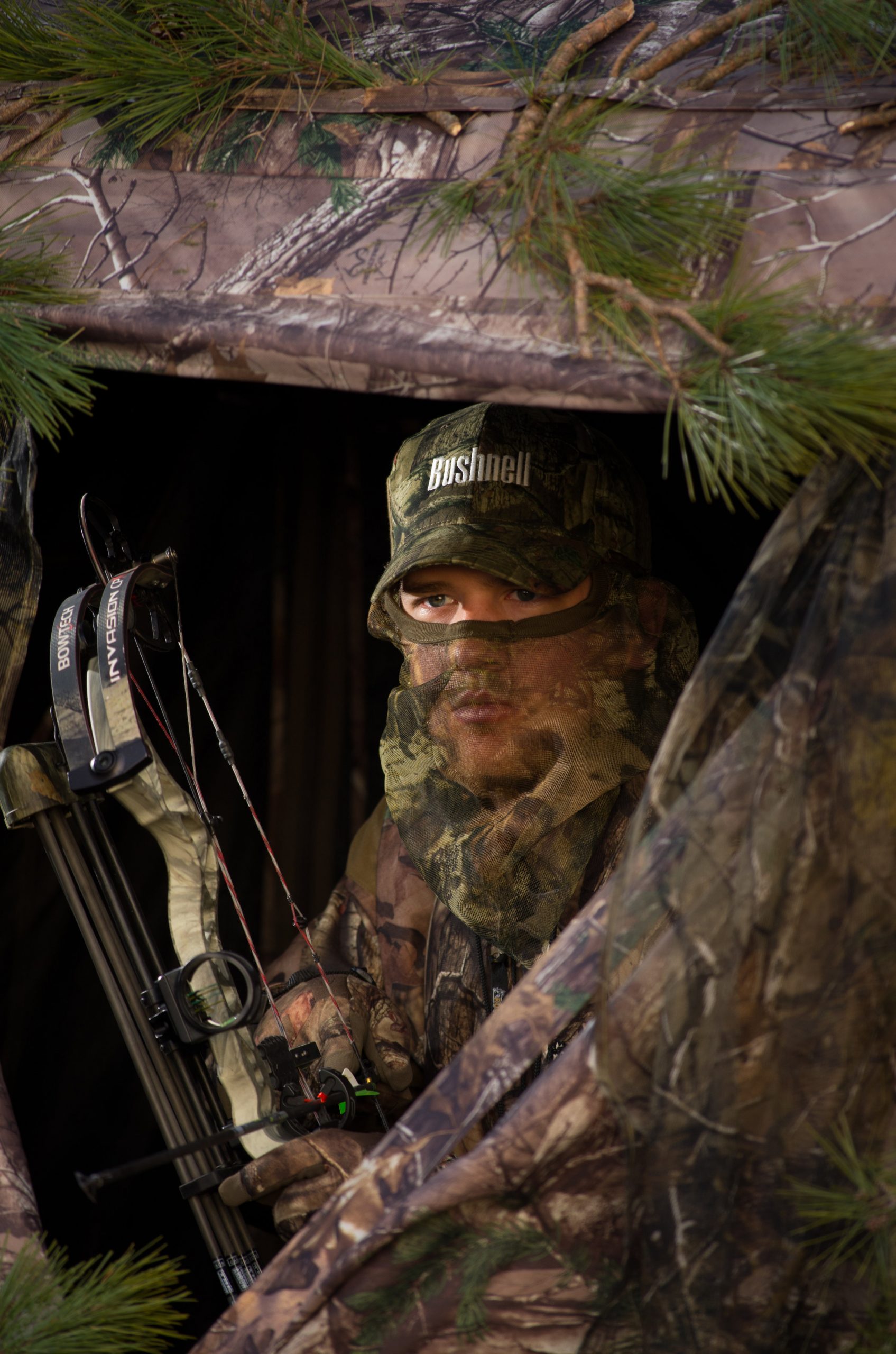
* Hunt in a Blind – “Once you get inside one of these lightweight, portable, total-concealment blinds, you can draw without the turkey seeing you,” Drury reports. “While hunting from a blind, I prefer to hunt the strut zones rather than the feeding areas or the roosting sites. Turkeys usually act more dependable at their strut zones, and they generally remain in their strut zones longer than around their roost trees or in their feeding areas. Brush-up around the blind with natural trees and limbs, since the turkey will know every tree and bush in that area.”
* Use Decoys – According to Drury, you really need to use a decoy in states where using a decoy is legal to keep the bird’s attention off the shooter. “Most bowhunters prefer to set out two jakes and one hen in their decoy spread within 10-12 yards of their blinds. Remember turkeys can react quickly to the sound of the bow.”
How David Hale Bowhunts Turkeys
David Hale, one of the founders of Knight & Hale Game Calls in Cadiz, Kentucky, explains, “When you hunt turkeys with a gun, you must remain very conscious of your movement to not spook the bird. As a bowhunter, you have to not give away your position when you attempt to draw your bow or move your bow to take the shot. You have to expect to be unsuccessful bowhunting a turkey more times than you’re successful. I use a mechanical release and camo paint on my hands and face rather than wearing camo gloves. If you wear a glove and shoot a release, oftentimes the glove will make you shoot before you want to take the shot.”
When Hale gets ready to draw his bow, he picks a place in the woods where the turkey will have to step behind a bush or brush to give him those few seconds required to make the draw. Once Hale pulls his bow to full draw, he favors a shot at the turkey’s back. “I prefer to make a spine shot. If the bird walks away from me or puts his back to me, I’ll have the opportunity to shoot for the spine. If the turkey begins to strut, I’ll shoot for the spot where the wings join the body in an effort to get a spine shot. If you shoot into the turkey’s breast, more than likely you’ll lose the bird. If the turkey has his tail fanned in a strut with his back to me, I’ll shoot for the spot where the tail feathers join the body.
“When I hunt with a good bowman who hasn’t hunted or called turkeys very much, I like to use a three man team to get the novice turkey hunter a shot. We’ll set a turkey decoy in front of the blind to get the bird’s attention. But, always know the state regulations where you’re hunting before using decoys. Then the archer can concentrate on his equipment and making the shot.

“The second man in the blind describes the turkey’s movement and tells the bowman when he should take the shot at the turkey without spooking the bird. Many times the archer is so focused on the bird and where he wants to place the shot that he doesn’t see anything or everything going on around the gobbler he’s planning to shoot.
“The third hunter, the caller, sits 10-20-yards behind the blind, calling to the turkey and trying to work the bird in front of the archer. The caller needs to sit behind the blind, so the turkey’s attention is not focused on the blind. If you call from inside the blind then that’s where the turkey will be looking. Of course, you don’t want the turkey looking at the blind when he gets within bow range because the gobbler may spot the hunter as he draws his bow. Also, by the caller being outside the blind, if the gobbler starts drifting away from the blind, the caller may have an opportunity to move further away from the blind and start calling like a hen that’s leaving the area.”
Always remember you’ll miss more gobblers than you’ll bag when hunting turkeys with a bow. But with each miss and every mistake, you’ll inch closer to success.
More Info on Turkey Hunting
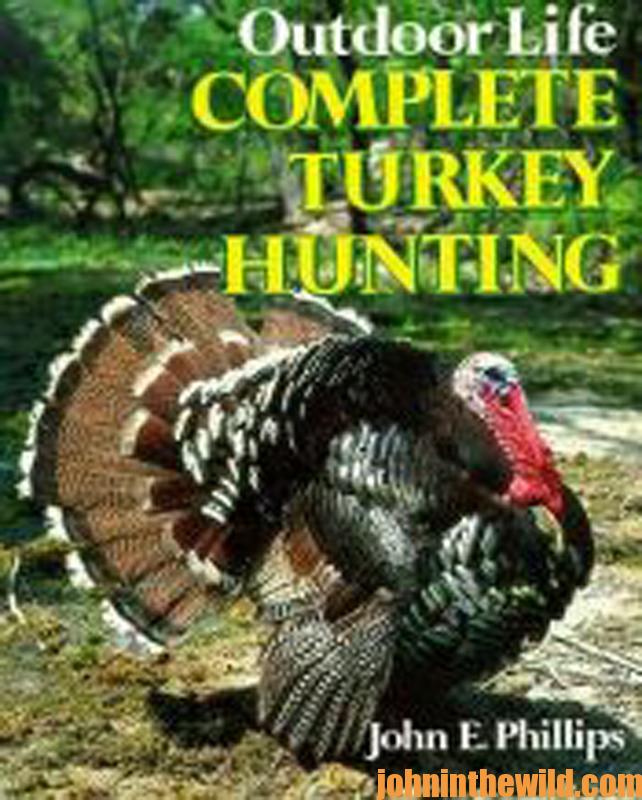
For more info on hunting turkey, check out John E. Phillips’ books, available in Kindle and some also in print and Audible (http://johninthewild.com/books#turkey). To receive and download for free “The Turkey Gobbler Getter Manuel,” by John and Denise Phillips, go to http://johninthewild.com/free-books.
Sidebar: Turkey Broadhead Testing 2017
The National Wild Turkey Federation tested some paper-tuned turkey broadheads in 2017, and here are the results:
* Dirt Nap Gear – Both Mechanical/Fixed Hybrid; 2nd least penetration at 4-7/16-inches.
* Dirt Nap Gear – Shred Head Fixed; penetrated to 4-3/4-inches.
* Innerloc – 3-blade Expandable; penetrated to 5-3/4-inches.
* Muzzy – Trocar Hybrid; penetrated only to 4-3/8-inches.
* Rage – Turkey Xtreme Expandable; penetrated to 6-inches – the deepest of broadheads tested.
* Shrapnel – Expandable; penetrated at 5-1/4-inches.
* Wasp – Jak-Hammer Expandable; penetrated 5-3/4-inches.
* Wac’Em – 3-blade Expandable; penetrated 5-1/2-inches.
Other well-known turkey bowhunting tackle:
* NAP Spitfire Gobbler Getter – 100 grains and a cutting diameter of 1-1/2-inches. Rounded point delivered maximum shock.
* Wraith Turkey Body Shot – Universal ferrule benefits. Accepts any Wraith blade style and Scooptail design accomplishes in-flight accuracy with a snowplow effect to deliver maximum penetration.
This article first appeared in the March 2019 print issue of Great Days Outdoors Magazine. For more great hunting and fishing content for the deep South, subscribe to Great Days Outdoors print and digital editions or click the image to download this issue.

